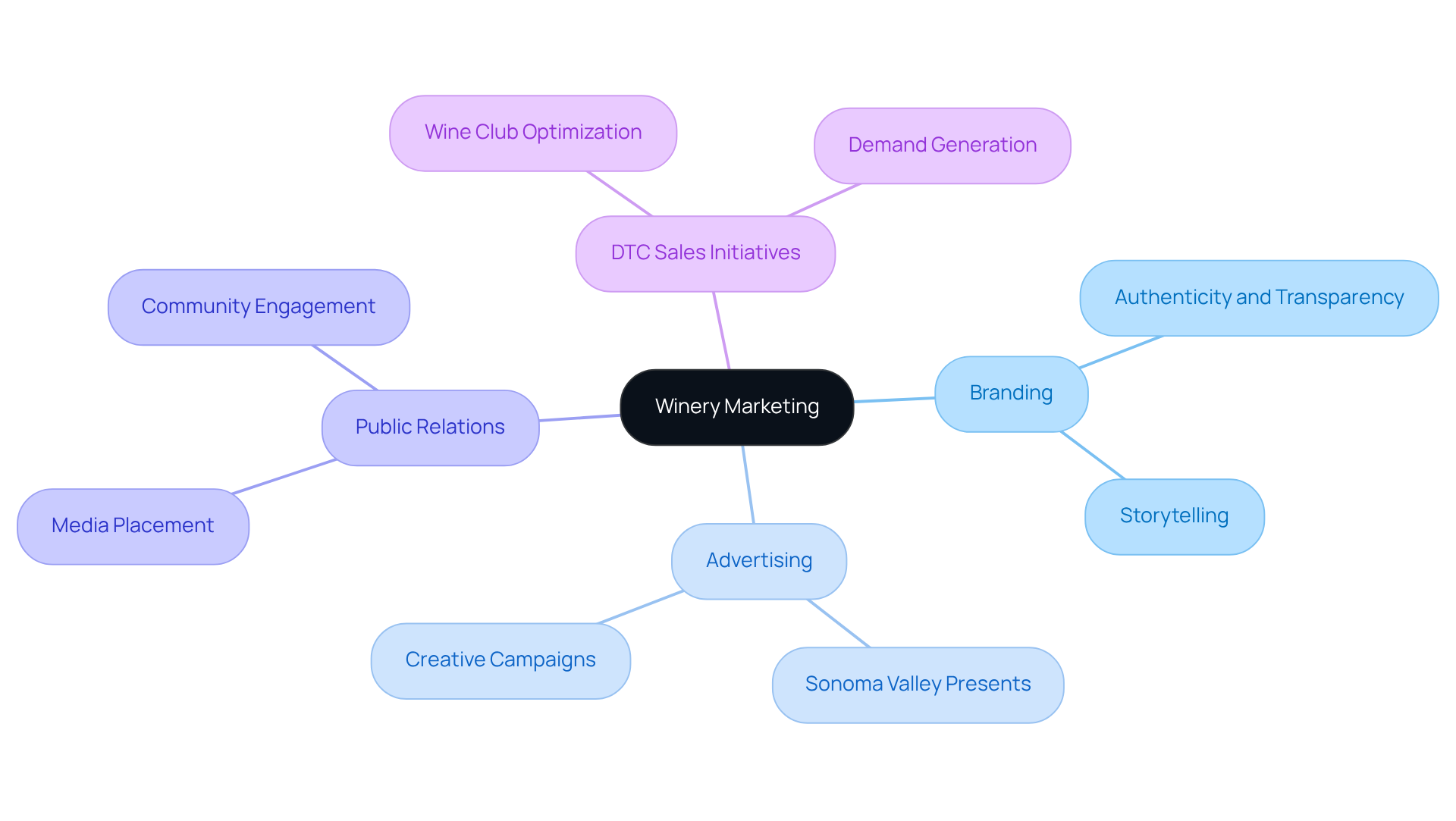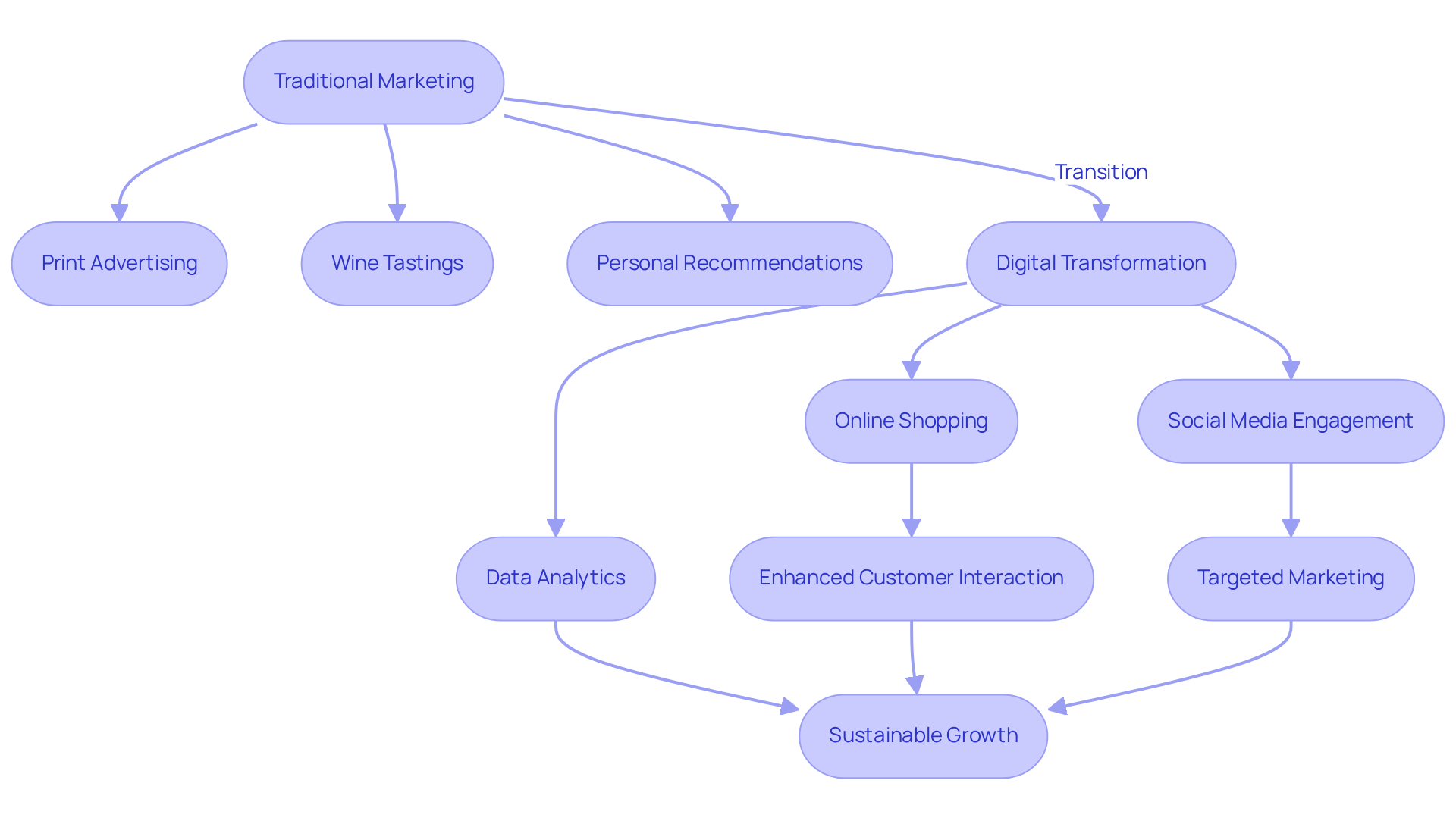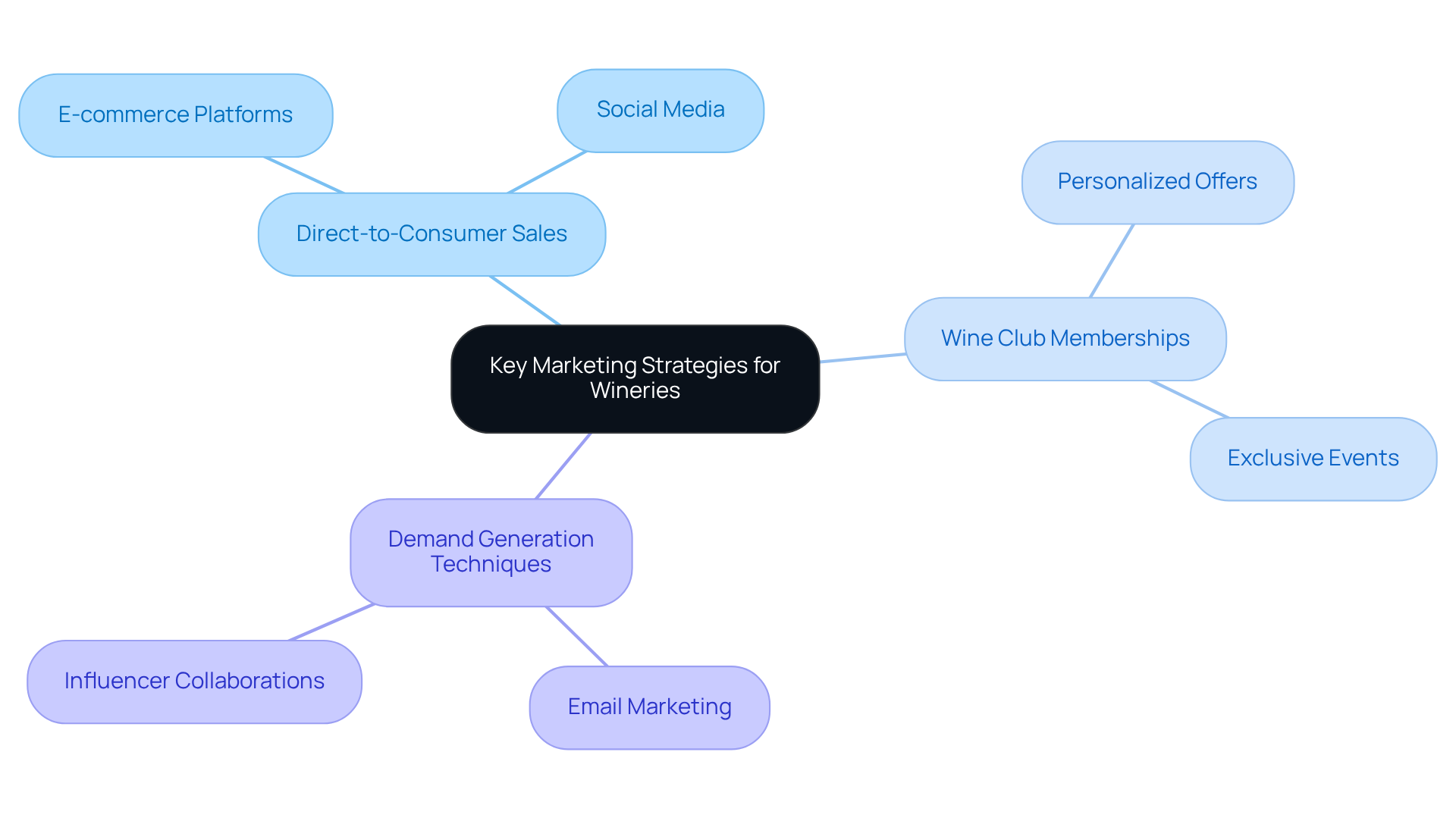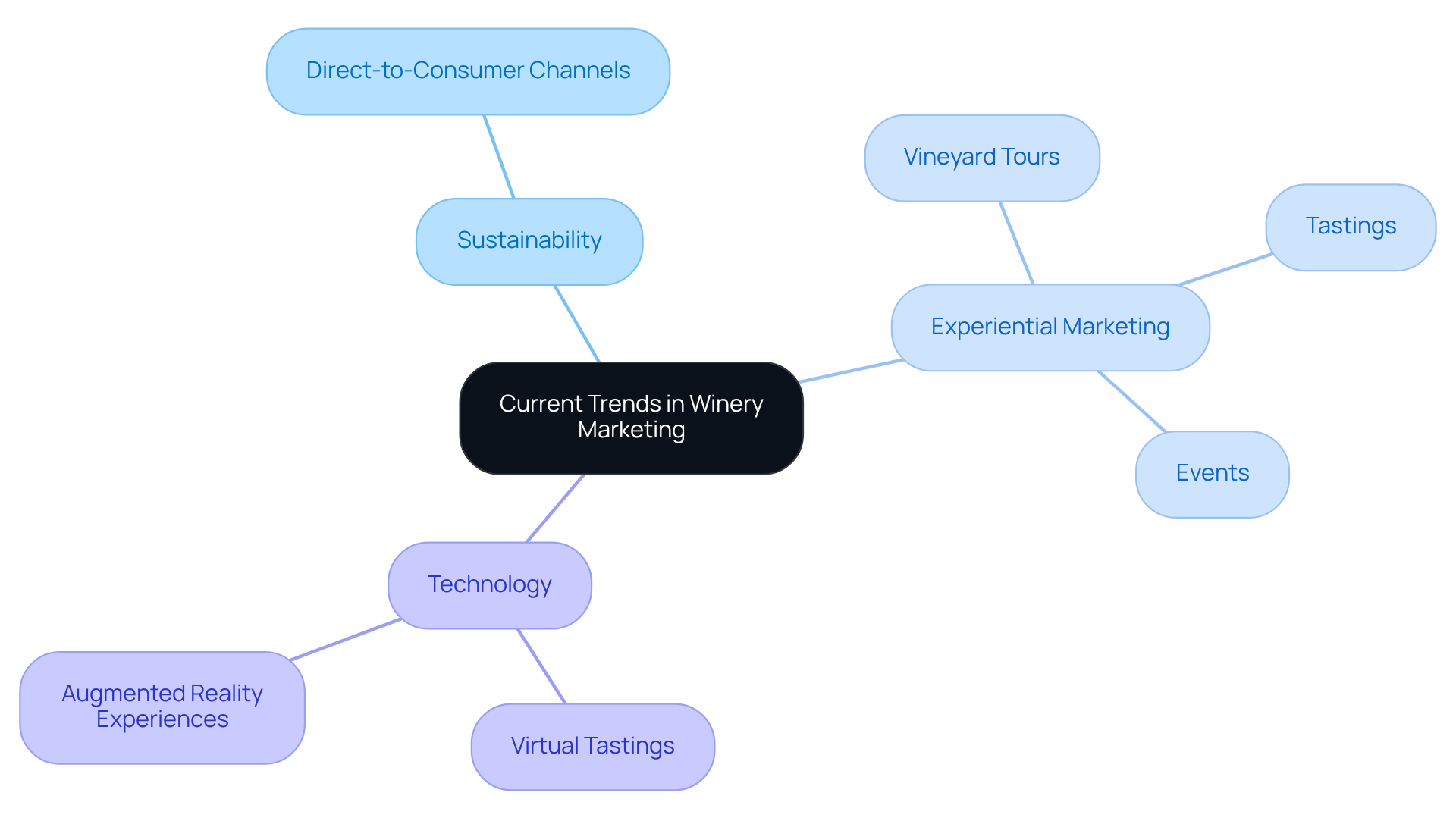Overview
This article presents a comprehensive overview of the essential concepts and trends in winery marketing, underscoring the critical need for effective strategies that enhance visibility, customer engagement, and sales within a competitive landscape.
The discussion begins with the evolution from traditional marketing methods to contemporary digital strategies, illustrating the paramount importance of direct-to-consumer sales and personalized customer experiences.
Furthermore, it highlights the integration of technology as a vital component in adapting to shifting consumer preferences, ultimately driving sustainable growth in the industry.
By embracing these strategies, wineries can position themselves to thrive in an ever-evolving market.
Introduction
The winery marketing landscape is experiencing a significant transformation, necessitated by the imperative to distinguish oneself in an ever-crowded marketplace. As vineyards endeavor to forge meaningful connections with consumers, they are uncovering that robust marketing strategies not only amplify visibility but also cultivate profound customer loyalty. Yet, in light of evolving buyer demographics and escalating consumer expectations, how can wineries recalibrate their marketing tactics to flourish in this fluid environment? Delving into the essential concepts, prevailing trends, and inventive strategies within winery marketing unveils vital insights that empower these establishments to adeptly navigate the intricacies of contemporary consumer engagement.
Defining Winery Marketing: Core Concepts and Importance
The strategies and tactics involved in marketing for wineries encompass the promotion of their offerings and the forging of connections with customers. This includes a spectrum of activities such as branding, advertising, public relations, and direct-to-consumer (DTC) sales initiatives. In 2025, the significance of vineyard promotion is underscored by its ability to distinguish a vineyard in a saturated market, cultivate customer loyalty, and ultimately drive sales. Effective promotion enhances a vineyard's visibility and weaves an engaging narrative that resonates with consumers, thereby increasing the likelihood of brand preference. Given the industry's focus on personal connections and storytelling, marketing for wineries emerges as a vital tool for achieving success.
Enocap's comprehensive advisory services play a pivotal role in this landscape, equipping family-owned vineyards with strategies to nurture DTC growth, refine brand storytelling, and secure strategic capital. By transforming casual visitors into devoted patrons through effective DTC strategies—including demand generation and wine club optimization—establishments can significantly bolster their e-commerce growth and customer retention.
Expert insights reveal that effective branding in vineyard promotion not only attracts buyers but also fosters enduring connections. The Sonoma Valley Presents campaign, which highlights curated wine experiences centered around themes such as WINE + FOOD and LIBRARY WINE TASTINGS, exemplifies how strategic promotion can enhance consumer engagement and drive sales. By crafting memorable experiences, establishments can strengthen customer loyalty and differentiate themselves in a competitive arena.
Moreover, case studies indicate that vineyards employing tailored promotion and digital interaction strategies have observed significant improvements in customer loyalty. The 2024 Wine Club/DTC Member Study, which surveyed the preferences of over 9,000 wine club participants, suggests that customized promotional strategies can effectively align with customer expectations and enhance satisfaction. This research highlights opportunities for improvement in wine club and DTC operations, emphasizing the necessity for vineyards to adapt to evolving buyer preferences.
As the market evolves, understanding the intricacies of marketing for wineries will be essential for wineries striving to thrive in a competitive landscape. Addressing challenges such as shifting buyer demographics and rising prices will further amplify the effectiveness of promotional strategies. Additionally, the growing consumer interest in sustainability and health-conscious choices underscores the importance of aligning promotional efforts with contemporary consumer values. By embracing these trends and leveraging Enocap's advisory services—including media placement & PR and strategic capital planning—vineyards can position themselves for future success.

The Evolution of Winery Marketing: From Tradition to Innovation
Historically, vineyard promotion relied heavily on print advertising, wine tastings, and personal recommendations. However, the advent of digital technology and evolving buyer behaviors necessitates a transformation in marketing for wineries. The surge in online shopping and social media platforms has revolutionized how vineyards interact with customers, enabling direct engagement and customized promotional initiatives. A prime example is Cupcake Vineyards, which implemented advanced machine learning technology to refine audience targeting, achieving an impressive 18% sales increase compared to the control group and engaging 125,000 unique buyers, 49% of whom were new customers.
Today, wineries leverage data analytics to glean insights into consumer preferences, optimize their marketing for wineries, and strengthen their direct-to-consumer (DTC) sales channels. This evolution is highlighted by a remarkable 199% year-over-year rise in sweepstake QR scans during a recent campaign, illustrating the effectiveness of digital strategy integration. Furthermore, the use of rich media and display advertisements has proven to significantly boost conversion rates, with individuals exposed to both formats converting at rates 132.47% higher than those exposed to a single format.
This shift towards technology-driven, consumer-centric marketing for wineries embodies a broader trend in the wine industry, where the adoption of digital tools is crucial for enhancing brand storytelling and cultivating enduring relationships with consumers. As vineyards adapt to these changes, they position themselves for sustainable growth in an increasingly competitive landscape. Moreover, by focusing on strategic capital planning and generating predictable DTC revenue, family-owned businesses can bolster customer retention and foster loyalty through compelling brand narratives.

Key Marketing Strategies for Wineries: Driving Engagement and Sales
Effective marketing for wineries hinges on establishing robust direct-to-consumer (DTC) sales channels, optimizing wine club memberships, and implementing impactful demand generation techniques. To elevate DTC sales, producers must invest in user-friendly e-commerce platforms that facilitate seamless online shopping experiences. Social media plays a crucial role, enabling producers to connect with potential clients, showcase their unique offerings, and enhance brand recognition. Moreover, strategic financial planning is essential for vineyards to explore monetary opportunities, whether through debt, equity, or acquisition approaches.
Optimizing wine club memberships stands as another vital strategy. By delivering personalized offers and hosting exclusive events, wineries can cultivate loyalty and enhance customer retention. For example, tailored membership experiences that feature limited-edition releases or behind-the-scenes access can significantly boost member engagement.
Additionally, effective demand generation techniques, such as targeted email marketing campaigns and collaborations with influencers, are essential components of marketing for wineries to drive awareness and attract new customers. These strategies not only engage the audience but also foster a community around the brand, ultimately boosting sales and nurturing long-term relationships with consumers. By adopting these approaches, wine producers can adeptly navigate the competitive landscape and achieve sustainable growth.

Current Trends in Winery Marketing: Adapting to Consumer Preferences
Current trends in marketing for wineries underscore an imperative focus on:
- Sustainability
- Experiential marketing
- The strategic use of technology to enhance customer experiences
Wineries are increasingly prioritizing marketing for wineries to establish sustainable direct-to-consumer channels that not only drive consistent growth but also transform casual buyers into dedicated club members through proven strategies.
Consumers today actively seek brands that align with their values, making sustainability a pivotal focus for vineyards. Moreover, experiential marketing—encompassing vineyard tours, tastings, and events—provides establishments with the opportunity to craft unforgettable experiences that fortify connections with their clientele.
The integration of technology, including virtual tastings and augmented reality experiences, is rapidly gaining traction, enabling vineyards to engage patrons in innovative and compelling ways.
By harnessing strategic capital planning and articulating persuasive brand narratives, wineries can adeptly refine their marketing for wineries to address the evolving demands of consumers and unlock significant growth opportunities.

Conclusion
The marketing landscape for wineries is undergoing a significant transformation, highlighting the imperative for vineyards to adopt innovative strategies that align with modern consumer preferences. By effectively showcasing their distinctive offerings and cultivating deeper connections with customers, wineries can carve out a unique position in a competitive market, foster loyalty, and drive sales. The integration of technology, alongside a commitment to sustainability and experiential marketing, is essential in this evolution, allowing wineries to engage with consumers in impactful ways.
Key insights indicate that successful winery marketing relies on:
- Direct-to-consumer (DTC) strategies
- Personalized experiences
- Utilization of data analytics to customize promotions
The transition from traditional marketing approaches to digital platforms has empowered wineries to reach a wider audience, enhance customer engagement, and refine their sales channels. Furthermore, the significance of storytelling and brand narratives is paramount, as they are crucial in nurturing lasting relationships with consumers.
As wineries navigate this dynamic landscape, it is vital to remain agile and proactive in responding to emerging trends and consumer values. By prioritizing sustainability, leveraging technology, and crafting unforgettable experiences, wineries can not only satisfy the evolving expectations of their clientele but also position themselves for sustainable growth in the future. Embracing these strategies will be pivotal in shaping the future of winery marketing, ensuring that establishments thrive amid the challenges of an ever-evolving marketplace.
Frequently Asked Questions
What is winery marketing and why is it important?
Winery marketing involves strategies and tactics to promote wine offerings and connect with customers. It includes branding, advertising, public relations, and direct-to-consumer (DTC) sales initiatives. Its importance lies in distinguishing a vineyard in a saturated market, cultivating customer loyalty, and driving sales.
How can effective promotion enhance a vineyard's visibility?
Effective promotion enhances a vineyard's visibility by creating an engaging narrative that resonates with consumers, increasing the likelihood of brand preference and ultimately driving sales.
What role does Enocap play in winery marketing?
Enocap provides comprehensive advisory services to family-owned vineyards, helping them nurture DTC growth, refine brand storytelling, and secure strategic capital, thereby transforming casual visitors into devoted patrons.
What are some effective DTC strategies for wineries?
Effective DTC strategies include demand generation and wine club optimization, which can significantly bolster e-commerce growth and customer retention for wineries.
Can you give an example of a successful winery marketing campaign?
The Sonoma Valley Presents campaign highlights curated wine experiences centered around themes like WINE + FOOD and LIBRARY WINE TASTINGS, demonstrating how strategic promotion can enhance consumer engagement and drive sales.
What does the 2024 Wine Club/DTC Member Study reveal about customer preferences?
The study, which surveyed over 9,000 wine club participants, indicates that customized promotional strategies can effectively align with customer expectations and enhance satisfaction, highlighting opportunities for improvement in wine club and DTC operations.
What challenges do wineries face in marketing?
Wineries face challenges such as shifting buyer demographics, rising prices, and the need to align promotional efforts with contemporary consumer values, including sustainability and health-conscious choices.
How can wineries adapt to evolving market trends?
Wineries can adapt by embracing trends such as sustainability, leveraging advisory services like media placement & PR, and strategic capital planning to position themselves for future success.




